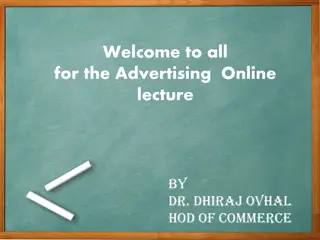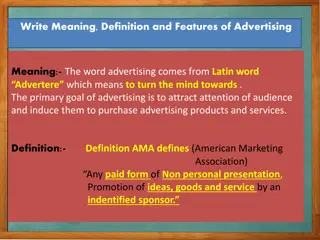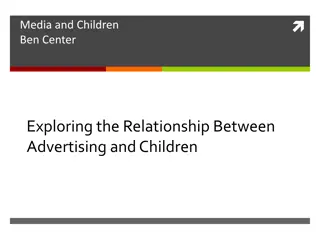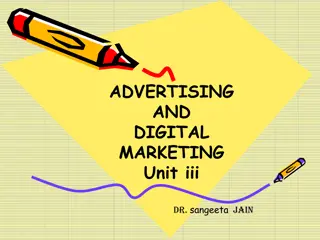Understanding Advertising Principles and Components
Providing an in-depth overview of advertising, this content explores the role of advertising in marketing, key components, and important types of advertising. It delves into the evolution of advertising, its impact on current practices, and its societal implications including regulations and ethics. Key principles, factors, and components of effective advertising are also discussed.
Download Presentation

Please find below an Image/Link to download the presentation.
The content on the website is provided AS IS for your information and personal use only. It may not be sold, licensed, or shared on other websites without obtaining consent from the author. Download presentation by click this link. If you encounter any issues during the download, it is possible that the publisher has removed the file from their server.
E N D
Presentation Transcript
Learning Outcomes Provide an introduction to advertising its role, key components, and key players. Define advertising s role in marketing including key players and new developments Explain whar are the most important types of advertising Examine how advertising has evolved, and how these developments affected current advertising practice. Examine advertising s relationship to society including regulations and ethics in advertising.
What is Advertising ? Advertising Paid, non- personal communication through various media about a business firm, not-for-profit organization, product, or idea by a sponsor identified in a message that is intended to inform or persuade members of a particular audience. A complex form of communication using objectives and strategies to impact consumer thoughts, feelings, and actions A form of marketing communication (all the techniques marketers use to reach their customers and deliver their messages)
Factors that define Advertising 1. Paid communication 2. Sponsor is identified 3. Tries to inform or persuade 4. Reaches a large audience 5. Message conveyed through many different kinds of largely nonpersonal mass media Main Principle An effective advertisement is one that can be proven to meet its objectives.
1. Advertising Strategy The strategy is the logic and planning behind the ad that gives it direction. Advertisers develop ads to meet objectives. Advertisers direct ads to identified audiences. Advertisers message that speaks to the audience s concerns. Advertisers run ads in the most effective media. create a
2. The creative concept The creative concept is the central idea that grabs the consumer s attention and sticks in the memory. Planning strategy requires creative problem solving. Research involves creativity. Buying and placing ads requires creative thinking.
3. The creative execution Effective ads are well executed reflecting the highest production values in the industry. Clients demand the best production the budget allows.
4. The media planning Television, Internet, magazines, newspapers and other media are used to reach a broad audience. Deciding how to deliver the message requires creativity. Main Principle In advertising how you say something and where you say it is just as important as what you say.
Roles of Advertising Marketing Communication Economic Societal
Roles of Advertising Marketing 1. The Marketing Role Marketing is satisfying customer wants and needs by providing products (goods, services, and ideas). The marketing department is responsible for selling the product using the 4 Ps (product, price, place/distribution, and promotion) and brand development.
Roles of Advertising Communication 2. The Communication Role Advertising is a message to a consumer about a product, designed to create a response. It is also a form of marketing communication. Advertising uses mass communication to transmit product information to connect buyers and sellers in the marketplace.
Roles of Advertising Economic 3. The Economic Role Since it reaches large groups of people, advertising makes marketing more cost-efficient if well executed. Advertising creates a demand for a brand using hard sell (persuading) and soft sell (image building) techniques.
Roles of Advertising Societal 4. The Societal Role Informs consumers about innovations and how to use them. Helps us compare products and features Mirrors fashion and design trends and helps shape consumer self-image Presents images about diversity in our world
Types of Advertising Institutional Advertising Brand Advertising Non-Profit Advertising Direct Response Public Service Advertising
Objectives of Advertising Inform Persuade Remind Informative advertising Promotion that seeks to develop initial demand for a good, service, organization, person, place, idea, or cause. Reminder advertising Advertising that reinforces previous promotional activity by keeping the name of a good, service, organization, person, place, idea, or cause before the public Persuasive advertising Promotion that attempts to increase demand for an existing good, service, organization, person, place, idea, or cause
Informative Persuasive Reminder
Key players in advertising The The Agency The Media Suppliers advertiser Wants to send out a message about its business Initiates effort by identifying a problem that advertising can solve Selects the target audience, sets the budget, and approves the ad plan Agencies have the strategic and creative expertise, media knowledge, talent, and negotiating abilities to operate more efficiently than the advertiser Media are channels of communication that carry the message to the audience. Group of service organizations that assist advertisers, agencies, and media in creating and placing ads by providing specialized services Artists, writers, photographers, directors, producers, printers, freelancers, and consultants
Key players in advertising The Audience People to whom an ad is directed their responses determine if advertising is effective. Targeting is the process of identifying the people in the desired audience. Interactive technology allows ads to be customized to the target audience s individual needs.
Advertising Strategies Comparative Testimonials Interactive Comparative advertising Interactive advertising Involves two-way promotional messages transmitted through communication channels that induce message recipients to participate actively in the promotional effort Celebrity Testimonials Emphasizes messages with direct or indirect promotional comparisons between competing brands Use of celebrity spokespeople for products Can build brand equity but can hurt brand if celebrity is hit by scandal
Advertising Strategies Comparative Testimonials Interactive
Advertising Principles The End























